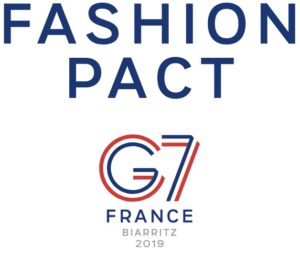
Why
• The global fashion industry is one of the largest, most dynamic and influential industries on the planet, generating over EUR 1.5 trillion a year in revenues1. It is one of the most impactful and therefore should also have the power to play a pivotal role in leading the shift towards a more sustainable future.
• We need to show that we can build coalitions of committed public and private leaders that can make a difference on these challenges by scaling new solutions and massively redirecting investment flows towards low-carbon, low biodiversity impacts and resilient development.
• Multi-sectorial initiatives will be key to get results in order to minimize the environmental impacts fashion and textiles have across oceans, climate and biodiversity. WhoWe aim for representation of at least 20 % of the global fashion industry as measured by volume of products. The goal would be to have a mix of luxury, “mid-level” and “affordable” brands across the fashion sector.
What
• In recognition of the United Nations” Sustainable Development Goals (the “UN SDGs”) and the interrelatedness of our global challenges and solutions, we recognize that our living natural capital is in danger and that this needs to be remedied to have a foundation for a thriving society and business.
In this document, the focus is on the three pillars: Climate, Biodiversity and Oceans.
• The “Pact” contains best efforts that are concrete (i.e. visionary but achievable) and that intend to directly address each of the priority areas. In addition to any already ongoing activities, each member company may choose appropriate courses of action from the possibilities listed as examples below each commitment, to achieve the objectives defined in the Pact.
• There should be quantitative targets based on science that can be achieved by both individual companies as well as the industry as a whole. The targets are broad enough to be meaningful to a group of fashion brands that account for a significant share of the fashion industry.
1 Global Fashion Agenda and The Boston Consulting Group (2017). Pulse of the Fashion Industry 2017.
How
• Acknowledging the substantial work that has been done to date by the fashion sector on environment, social and labor in significant parts of the supply chains, recognizing that resource extraction and initial processing result in the majority of impacts on biodiversity, climate change, and oceans and responding to the urgent need to focus action on the “gaps”. In particular we need also to address the interface of our business with Nature, so that all commitments will focus on the “first mile” of fashion supply chains, as a big unaddressed part of the impacts of the industry are felt at farm level and in raw material sourcing locations.
• The “Pact” will not reinvent the wheel but create an overarching framework for action in relation to the One Planet Lab work streams. This includes direct links to the significant work already taking place in existing initiatives within the fashion sector in the manufacturing part of supply chains. The new targets will build on the existing initiatives such as Apparel Impact Institute, C&A Foundation, Ellen MacArthur Foundation, Fair Fashion Center, Fashion For Good, Sustainable Apparel Coalition, Textile Exchange, The United Nations Framework Convention on Climate Change (UNFCCC), UN International Labour Organization/Better Work, ZDHC. The aim is to ensure that new actions will fill the “gaps” across fashion supply chains.Three levels of action
I. Global commitments:These respond to the priorities set by the global community through the UN SDGs, Planetary Boundaries and all the UN Conventions. They include commitments in three main areas pointed out by the One Planet Lab, as well as actions that are not mandatory but serve as examples of potential initiatives to reach the commitments:
A _ Climate: mitigating & adapting to climate change
B_ Biodiversity:bending the curve on biodiversity loss within 10 years
C _ Oceans: addressing the critical loss of ocean functionality due to climate change and pollution
II. Concrete joint initiatives:these are specific areas of work that require collaboration across brands/companies and all stakeholders of the fashion industry.
III. Accelerators:these are actions that cut across the commitments and that create the enabling environment to achieve the targets. These may also be areas for collaboration within fashion as well as across sectors and that demonstrate leadership and innovation by the fashion industry
NOTE
The Fashion Pact is based on the collective ambition of CEOs to commit to sustainability targets that are needed to bend the curve on climate, biodiversity and fight against the pollution of our oceans. The document is not legally binding and can be seen as a set of guideline
https://www.ecologique-solidaire.gouv.fr/sites/default/files/Fashion%20Pact_G7_EN.pdf
https://www.ecologique-solidaire.gouv.fr/sites/default/files/Fashion%20Pact_G7_FR.pdf